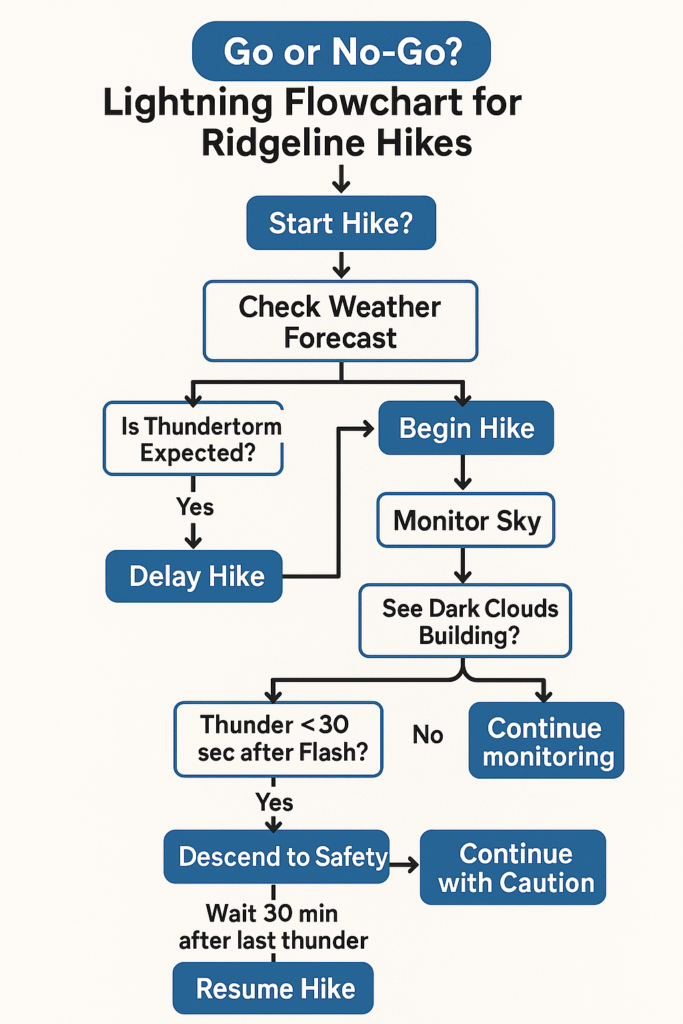Caught in the Storm: A Hiker’s Brush with Lightning
It was a warm afternoon in July when Mia and her hiking group reached the ridgeline of Mount Elden. The sky was blue when they began, but within an hour, distant thunder echoed across the canyon. The clouds built fast. Mia remembered something called the 30/30 rule and urged her group to leave the ridge. Minutes later, lightning struck a nearby tree where they had just been standing. That day, knowledge—not luck—saved them.
Hiking above the treeline during monsoon season or storm-prone months adds a serious risk: lightning. Ridgelines and summits are especially dangerous, acting as natural lightning attractors. But with good timing, awareness, and sound decision-making, hikers can avoid becoming statistics.
The 30/30 Rule: When to Seek Shelter
What it is:
The 30/30 rule is a simple guideline used to determine how close lightning is and when it’s time to get to safety.
How it works:
- First 30: If the time between the lightning flash and thunder is 30 seconds or less, the storm is within 6 miles—close enough to strike. Seek shelter immediately.
- Second 30: Wait at least 30 minutes after the last thunderclap before resuming outdoor activity.
Why it matters:
Lightning can strike from up to 10 miles away, even when skies appear clear. The 30/30 rule gives you a practical buffer for safety.
Spread Out to Stay Safe: Dispersal Spacing
If you’re caught in a storm on the ridge and can’t get to a safe structure, dispersal is crucial.
How to disperse safely:
- Minimum 20 feet apart: Each person in the group should be at least 20 feet (6 meters) from the next. This reduces the risk of multiple casualties from a single strike.
- Crouch low, feet together: If lightning is imminent (you feel hair standing, hear buzzing), assume the lightning position: crouch low, minimize contact with the ground, and cover your ears.
Avoid grouping together, even if it feels safer psychologically. Spacing out increases the odds that someone remains uninjured and can call for help.
Myth-Busting: Lightning Safety Misconceptions
Myth #1: Metal jewelry attracts lightning.
Fact: Lightning is not attracted to metal per se. It’s drawn to the tallest object in the area. While metal conducts electricity, wearing small metal items like necklaces or rings doesn’t increase your risk.
Myth #2: Lightning never strikes the same place twice.
Fact: It often does! Tall points like ridgelines, towers, and peaks may be struck repeatedly.
Myth #3: Rubber soles protect you.
Fact: The voltage from a lightning strike is so high that rubber soles offer no meaningful protection.
Myth #4: You’re safe if it’s not raining.
Fact: Lightning often strikes ahead of storm fronts. If you hear thunder, you’re already at risk.
Go or No-Go? Lightning Flowchart for Ridgeline Hikes
When monsoon clouds build, don’t rely on guesswork. Use this flowchart to make informed decisions:

Key Tips:
- Always check local lightning forecasts before heading out.
- Morning hikes reduce risk—storms often build in the afternoon.
- Carry a NOAA weather radio or use a hiking app with live radar.
Further Reading & Resources
Covers all aspects of lightning safety, including outdoor activities, emergency response, and statistics.
Guidelines for handling weather changes on the trail, including lightning and thunderstorms.
Debunks common misconceptions about lightning risks and tells you what really matters.
Basic first-aid steps to take if someone is struck by lightning.








